Types of Chainsaw Chains and How to Choose
- January 4, 2024
- 6 comment
In the world of chainsaw maintenance and usage, understanding the intricacies of chainsaw chains is crucial for both safety and efficiency. Today, we delve into the different types of chainsaw chains – full chisel, semi chisel, skipped chains – and explore why choosing the right one for your task is essential.
Understanding the Chainsaw Chain
To make an informed decision when selecting a chainsaw chain, it’s crucial to first understand its basic components and the key specifications involved. A chainsaw chain is more than just a loop of metal; it’s a complex assembly of cutters, links, tie links, and rivets, each playing a vital role in the chain’s functionality and compatibility with your chainsaw.
Key Components of a Chainsaw Chain
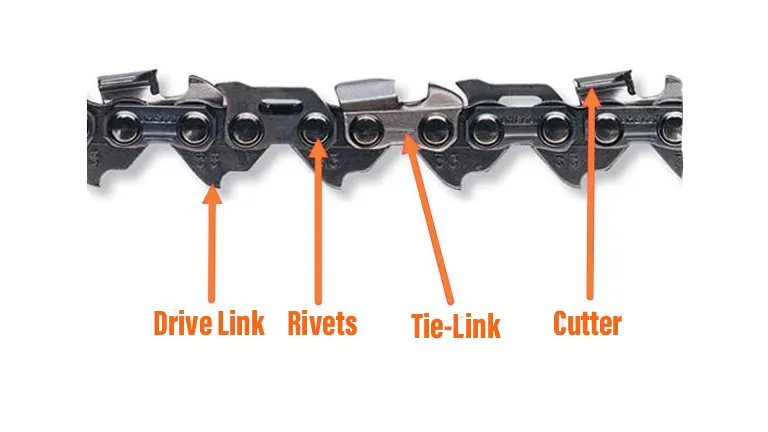
- Cutters: These are the teeth of the chain that do the actual cutting. They come in various types, as discussed earlier.
- Links: These connect the cutters and maintain the chain’s integrity.
- Tie Links: These help in keeping the cutters in place.
- Rivets: They act as the pivot points for the links and cutters, allowing the chain to flex and rotate around the bar.
Essential Specifications for Chain Selection
Pitch
This is a crucial measurement and refers to the size of the chain. It is determined by measuring the length between three consecutive rivets and then dividing by two. The pitch indicates the chain’s size and helps in matching it to the correct chainsaw.
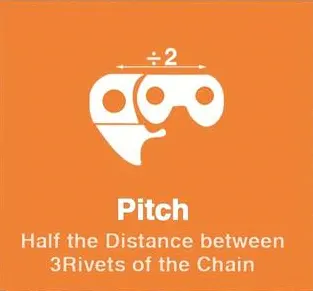
Drive Links
This number represents the total count of links that engage with the chainsaw bar. It’s critical because it determines the length of the chain. An incorrect drive length number would result in a chain that either doesn’t fit or doesn’t function properly on your chainsaw.
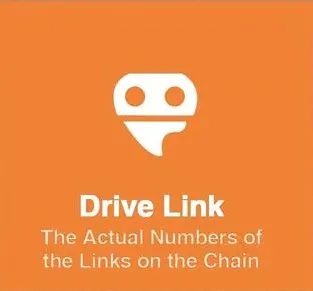
Gauge
The gauge measures the thickness of the drive links, particularly where they fit into the guide bar. It’s essential for ensuring a snug fit. A chain with an incorrect gauge can either be too loose, leading to a risk of coming off the bar, or too tight, causing seizing and increased wear.
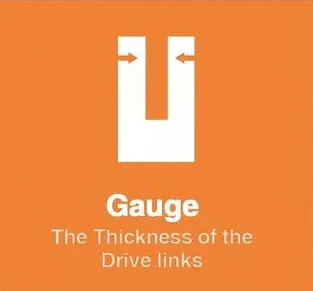
Bar Length
While not a direct part of the chain, the bar length of your chainsaw plays a significant role in determining the correct chain. It’s essential to match the chain to the bar length for optimal performance and safety.
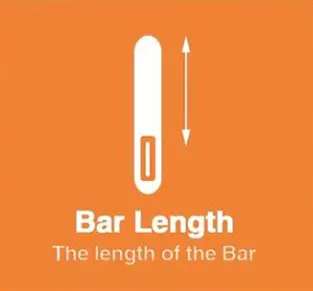
Understanding Chainsaw Chain Types: From Cutting Teeth to Specialty Chains
Types of Cutting Teeth
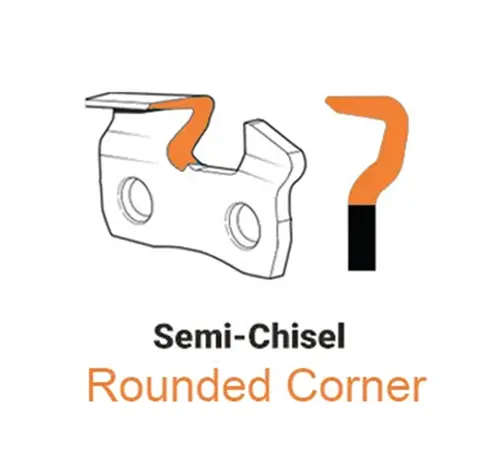
Ideal for most homeowners, the semi-chisel cutter is a versatile component of a chainsaw chain. It’s easily identifiable by its curved shoulder, a design element that makes it less aggressive compared to other types. The major benefits of semi-chisel cutters include their longevity in sharpness, easier sharpening process, and a significantly reduced risk of kickback, which is a key safety consideration. However, one of the drawbacks of this type of cutter is its slower cutting speed, especially when compared to full chisel cutters.
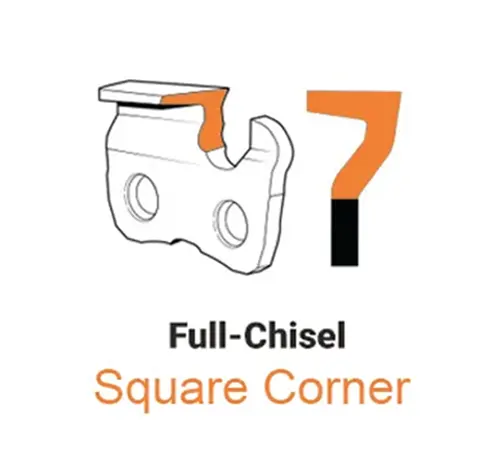
Designed primarily for commercial or experienced users, full chisel cutters are distinguished by their sharp shoulders. These cutters are adept at taking larger chunks of wood, thereby facilitating rapid cutting action. This makes them highly efficient for heavy-duty tasks. However, they do come with a set of cautions: a higher propensity for kickback, a more challenging sharpening process, and a tendency to dull quickly, particularly when exposed to dirt and debris.
Specialty Chains
Low Profile (Low Pro) Chains
These chains are best suited for chainsaws with low horsepower or for electric models. Characterized by their shorter cutters which result in shallower cuts, low profile chains offer advantages such as being lighter and safer, making them an ideal choice for less powerful saws.

Narrow Kerf Chains
The primary benefit of narrow kerf chains is their ability to remove less wood, which in turn decreases friction and enhances the cutting speed. This feature is particularly beneficial for chainsaws with lower power, where maximizing efficiency is crucial.
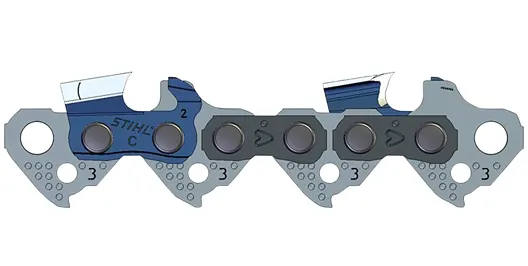
Low-Kickback Chains
Specifically designed for enhanced safety, Low-kickback chains feature additional metal that smooths the transition around the bar’s nose. This design greatly reduces the risk of kickback, making these chains well-suited for general yard work. However, they do have limitations, such as restricting certain cutting techniques like bore or plunge cuts.
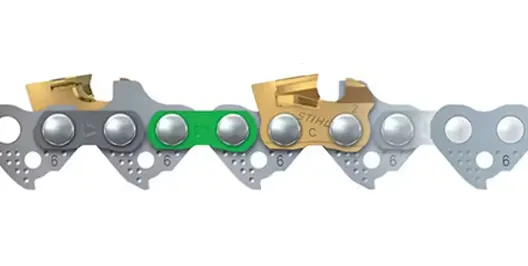
Ripping Chains
Primarily used for milling or cutting along the grain of a log, ripping chains are characterized by cutters set at a lower angle. This design allows them to produce finer and less aggressive cuts, making them ideal for specific types of wood cutting, particularly when precision is necessary.

Understanding Different Chainsaw Chain Configurations

- Semi Skip Chains: The semi skip chain offers a middle ground between standard and full skip configurations. In a semi skip chain, the arrangement of the teeth is a mix of the patterns found in standard and full skip chains. This design provides a balance of flexibility in cutting, making it a versatile choice for various applications. However, it’s important to note that semi skip chains are less popular compared to standard and full skip chains. Their specific use-case scenario often falls into a niche category, where the user requires a chain that strikes a balance between smooth cutting and reduced drag, without the specific advantages or drawbacks of the standard or full skip configurations.
- Full Skip Chains: Full skip chains are designed with a cutter placed every third drive length. This unique arrangement significantly reduces the chain’s drag, making these chains ideal for use with larger bars and saws typically found in more demanding, professional environments. The reduced number of cutting teeth means there’s less likelihood of the chain clogging during heavy-duty cutting. However, this advantage comes with certain drawbacks, such as an increased risk of kickback and a tendency for higher vibration during use. These factors make full skip chains more suited to experienced users who require chains for large-scale or intense cutting tasks.
- Standard Chains: Standard chains are characterized by having a cutting tooth on every other link. This configuration is particularly noted for providing smooth cutting and a high degree of versatility, which is essential for various cutting tasks. Standard chains are suitable for use with chainsaw bars up to 24 inches in length. This type of chain is often preferred for its balance between cutting efficiency and safety, making it a popular choice for both professional and casual users.
Each of these chain types serves a specific purpose and is optimized for different cutting conditions and chainsaw types. When selecting a chainsaw chain, it’s crucial to consider the nature of the work, the type of saw being used, and the user’s experience level to ensure optimal performance and safety.
Can a chainsaw chain be put on backwards?
A chainsaw chain can indeed be installed backwards, a common mistake if one is not cautious during assembly. Chainsaw chains have a designated direction for proper operation, and overlooking this detail can result in the chain being mounted in reverse, leading to ineffective cutting and potential safety hazards. It’s crucial to ensure the chain’s orientation aligns correctly with the manufacturer’s specifications to guarantee efficient and safe operation.
Conclusion
Understanding the nuances of chainsaw chains is essential for selecting the right chain for your task. Whether you’re a homeowner doing yard work or a professional in lumber, the right chain not only ensures efficiency but also maintains safety. Remember, the chain you choose should align with your saw’s specifications and the nature of the task at hand. With this guide, you’re now equipped to make an informed decision in selecting the most suitable chainsaw chain for your needs.
Related Articles:
- How Tight Should A Chainsaw Chain Be
- Best ATV Chainsaw Holder
- Best Chainsaw Mill Attachments
- Common Reasons Your Chainsaw Is Smoking
- Best Chainsaw for the Money: Top Picks for Every User
- Top 5 Causes of a Loose or Detached Chainsaw Chain: How to Identify and Fix
- Chainsaw Safety Guide Tips
FAQs
- What’s the difference between semi-chisel and full chisel chains?
Semi-chisel chains have a rounded cutting edge and are more durable and less prone to dulling quickly, making them ideal for cutting in dirty or gritty conditions. Full chisel chains, with their sharper, square-cornered teeth, cut faster but dull more quickly and are best used in clean wood. - Can I use a full skip chain on a small chainsaw?
Full skip chains are generally recommended for larger chainsaws and longer bars (over 24 inches) because they are designed for bulk cutting and can handle the increased power. Using a full skip chain on a small chainsaw is not advisable as it can reduce cutting efficiency and increase the risk of kickback. - How do I know when to replace my chainsaw chain?
A chainsaw chain needs replacing when it becomes dull and doesn’t cut efficiently even after sharpening, if the teeth are significantly worn down, or if there’s visible damage like broken or bent links. - What does the term ‘pitch’ in chainsaw chains mean?
Pitch refers to the size of the chain and is measured by the distance between any three consecutive rivets divided by two. It’s an important specification as it determines the fit of the chain on the chainsaw’s bar and sprocket. - Is it safe for a beginner to use a chainsaw with a full chisel chain?
While it’s not inherently unsafe, full chisel chains are more aggressive and prone to kickback. Beginners are typically recommended to start with a less aggressive chain, like a semi-chisel, to gain experience while minimizing risk. - What are the advantages of using a narrow kerf chain?
Narrow kerf chains are thinner and remove less wood, reducing the power needed to make a cut. This makes them ideal for smaller, less powerful saws, improving cutting efficiency and reducing the strain on the saw. - Can I interchange chains between different brands of chainsaws?
Chains can be interchanged between different chainsaw brands, provided they match in pitch, gauge, and drive link count. However, it’s crucial to consult the chainsaw’s manual to ensure compatibility. - Why do some chains have a ‘low-kickback’ feature?
Low-kickback features, often found in chains designed for consumer use, include specific design elements like guard links that reduce the risk and severity of kickback, making the chainsaw safer for less experienced users. - How often should I sharpen my chainsaw chain?
The frequency of sharpening depends on usage, but generally, a chain should be sharpened after every few hours of cutting time, or whenever the saw starts to produce sawdust instead of chips, or requires more pressure to cut. - What is a ripping chain, and when should I use it?
A ripping chain is designed for cutting parallel to the wood grain, such as in milling operations. It features a special tooth angle for smoother cuts in this specific direction and is not typically used for general chainsaw work.
Join the discussion below by sharing your experiences, tips, or reviews. Your contributions help others make informed decisions and navigate their chainsaw choices with confidence. Let’s build a community of shared knowledge for all wood-cutting enthusiasts!

David Murray
Forestry AuthorI'm David Murry, a forestry equipment specialist with a focus on chainsaw operation. With over 13 years of experience, I've honed my skills in operating and maintaining a wide range of machinery, from chainsaws to log splitters. My passion for the outdoors and commitment to sustainable forestry drive my work, which emphasizes safety, efficiency, and staying updated with industry advancements. Additionally, I'm dedicated to sharing my expertise and promoting environmental awareness within the forestry community.
6 comments
Thank you for adding to my education / understanding. I've been cutting with a chainsaw for over 55 years. And I'm about to buy my first "Real Professional" chainsaw. I think it's time to learn more of the reasons WHY things are designed the way they are.
Frank Woechan
January 9, 2024 4:53 pmI heard there are different chains fir green wood and dry wood. What are they
Wanda
January 7, 2024 7:07 pmGood job
Jerry
January 5, 2024 9:03 pmLooking for a great 16"chain to cut tree stump pine tree
Earl L Blannon
January 5, 2024 4:46 pmVery informative learned quite a bit

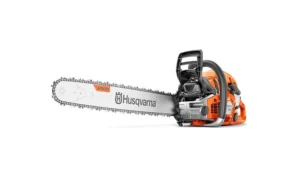
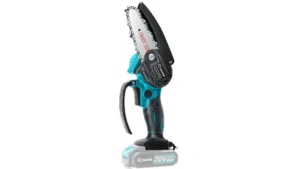

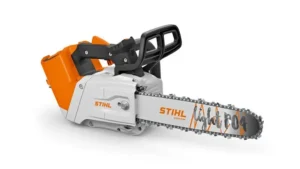

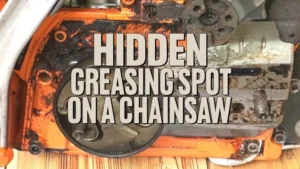

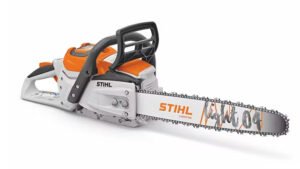

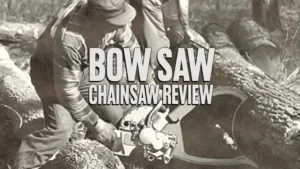
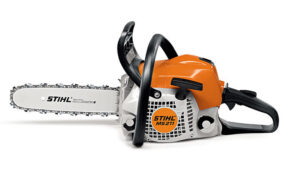
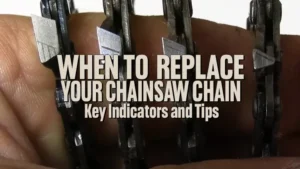
Thank you for the information on the types of chains. Quick question, is there some flexibility in the number of drive links? Husqvarna has a chain for my saw that shows 80 drive links for 20" bar, but Oregon has a chain with 78 links, same pitch and gauge, for a 20" bar. Thank you
John Baptist
January 19, 2024 9:37 am